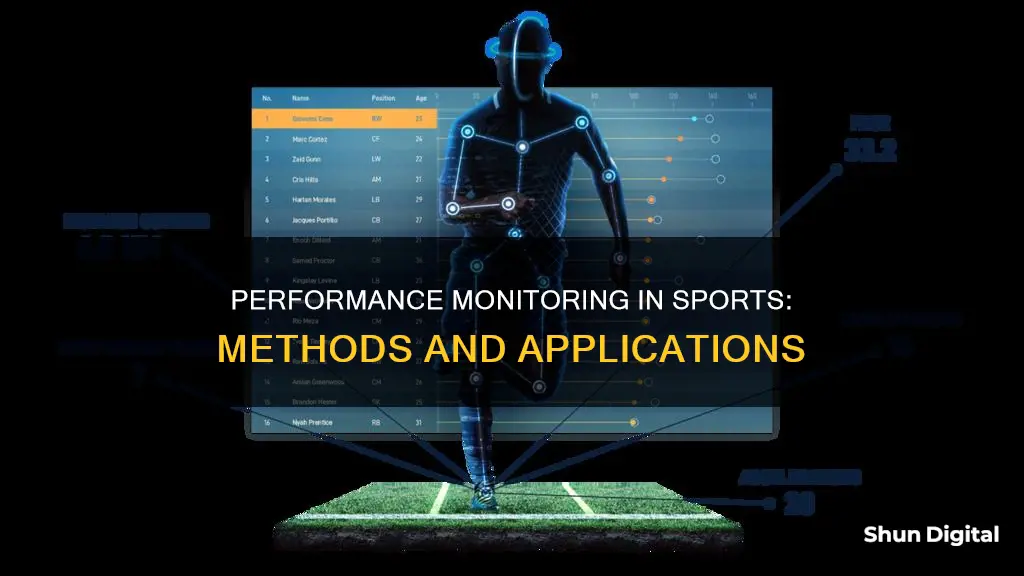
Performance monitoring in sports is an increasingly important area in sports science, with the aim of giving athletes the best care and support, and protecting them from harm. Monitoring can take the form of subjective and objective measures to indicate training load, stress/fatigue, and performance. Subjective measures include mood state, sleep quality/quantity, energy levels, muscle soreness, and academic stress, while objective measures include biochemical markers, immunological markers, and training duration and load.
Performance monitoring can help identify potential difficulties at the earliest possible stage and optimize training and preparation to ensure the best possible performance in competition. It can also help athletes avoid missing training sessions and maintain their health, both physically and mentally. Additionally, monitoring can assist in identifying potential problems such as injury, illness, and burnout, all of which can hamper an athlete's ability to train consistently.
Performance monitoring has become a huge part of a team's regime, as the process ultimately helps improve an athlete's performance and provides more insight for coaches and staff. Introducing an athlete monitoring system can help improve an athlete's performance through load management, life stressor monitoring, mental health and well-being monitoring, and self-awareness development.
| Characteristics | Values |
|---|---|
| Sensors | Heart rate, GPS, speed, cameras, accelerometers, lactate threshold sensors, wearable devices |
| Analysis | Real-time, trends, improvements, fatigue, load, risk, performance, health, stress, sleep, nutrition, injuries, illness, mental health, recovery, training, performance, playing style |
| Benefits | Monitoring, tracking, planning, optimising, reducing risk, maximising performance, improving communication, building excellence, promoting excellence, making decisions, educating, individualising training, balancing training, identifying talent, monitoring development, detecting, quantifying, streamlining, interpreting, adjusting, shaping, centralising, managing, streamlining record-keeping, improving efficiency |
What You'll Learn

Monitoring training load and fatigue
Variables to Monitor Training Load and Fatigue
There are a number of variables that can be used to monitor training load and fatigue, including:
- Sessions per day, week, and month
- Seconds, minutes, and hours
- Modality and environment
- Maximum mean power and jump height
- Number of efforts and quality of efforts
- Perception of effort and fatigue
- Questionnaires (e.g., REST-Q, VAS)
- Biochemistry and hormone analysis
- Baseline and response to exercise
- Total body weight, fat mass, and fat-free mass
- Quality, quantity, and routine of sleep
- Stress, anxiety, and motivation
External vs Internal Load
The load units can be categorized as external or internal. External load refers to the work completed by the athlete, measured independently of their internal characteristics. For example, in road cycling, this could be the mean power output sustained for a given duration. Internal load, on the other hand, refers to the relative physiological and psychological stress imposed on the athlete. Monitoring both external and internal loads is important for understanding the athlete's training load, and the relationship between the two may help reveal fatigue.
Methods for Monitoring External Load
Power Output, Speed, and Acceleration
Technologies such as power output-measuring devices (e.g., SRM, PowerTap) allow for the continuous measurement of work rate (power output). Training and competition data can be recorded and analyzed to provide information on parameters such as average power, normalized power, speed, and accelerations.
Time-Motion Analysis
Time-motion analysis (TMA), including global positioning system (GPS) tracking and movement pattern analysis via digital video, are commonly used to monitor athletes, especially during competition. TMA data is often associated with arbitrary and individualized speed thresholds.
Neuromuscular Function
Measures of neuromuscular function, such as jump tests, sprint performance, and isokinetic and isoinertial dynamometry, are often used in team sports due to their simplicity of administration and minimal additional fatigue induced.
Methods for Monitoring Internal Load
Perception of Effort
The rating of perceived exertion (RPE) is a common means of assessing internal load, based on the notion that an athlete can monitor their physiological stress during and after exercise.
Session Rating of Perceived Exertion (RPE)
This method involves multiplying the athlete's RPE (on a 1-10 scale) by the duration of the session (in minutes), providing a simple, valid, and reliable way to quantify training load.
Heart Rate (HR) Monitoring
HR monitoring is commonly used to assess internal load in athletes, based on the linear relationship between HR and the rate of oxygen consumption during steady-state exercise. Percentage of maximum HR is often used to prescribe and monitor intensity.
Heart Rate Recovery (HRR)
HRR is the rate at which HR declines after exercise and has been suggested as a marker of autonomic function and training status in athletes. It can provide information on the accumulation of fatigue.
Training Impulse (TRIMP)
TRIMP is a unit of physical effort calculated using training duration and maximal, resting, and average HR during the exercise session.
Lactate Concentrations
Blood lactate concentration is sensitive to changes in exercise intensity and duration but may be influenced by various factors such as ambient temperature, hydration status, diet, and sampling procedures.
Lactate to RPE Ratio
Similar to the HR-RPE ratio, the lactate to RPE ratio may be useful in determining internal load and identifying fatigue.
Biochemical/Hormonal/Immunological Assessments
Biochemical, hormonal, and immunological responses to exercise have been studied to monitor fatigue and minimize excessive fatigue and illness. However, no definitive marker has been identified, and these measures are often costly and impractical.
Questionnaires and Diaries
Questionnaires and diaries are a simple and inexpensive means of determining training load and subsequent responses, but they rely on subjective information that may need to be corroborated with physiological data.
Psychomotor Speed
Fatigued athletes often report impaired concentration and cognitive complaints, so investigating psychomotor speed might provide insight into the cognitive load induced by exercise.
Sleep Quality and Quantity
Monitoring sleep quality and quantity can help with early detection and intervention before significant performance and health decrements are observed. Simple diaries or non-invasive methods such as actigraphy can provide valuable information.
Current Monitoring Practices
Current best practices for monitoring fatigue in high-performance sports include self-report questionnaires, performance tests, and GPS monitoring. The most common reasons for monitoring include injury prevention, monitoring the effectiveness of the training program, maintaining performance, and preventing overtraining.
Key Features of a Sustainable Monitoring System
An effective and sustainable monitoring system should be intuitive, provide efficient data analysis and interpretation, enable efficient reporting of simple yet scientifically valid feedback, and be flexible and adaptable to different sports and athletes.
Repairing Your ASUS LCD Monitor Buttons: A Step-by-Step Guide
You may want to see also

Tracking performance and progress
Data Collection:
- Centralized Platform: It is essential to have all the data in one place. AthleteMonitoring, for example, offers a comprehensive platform to streamline data collection, analysis, and management.
- Wearable Technologies: Wearable devices, such as smartwatches, smart fabrics, and chest straps, can track biometric data like heart rate, sleep, and physical activity.
- Video and Motion Tracking: Video analysis systems, such as multiple semi-automatic cameras (VID) and local positioning systems (LPS), provide visual data on player movements, interactions, and performance.
- Questionnaires and Self-Reporting: Athletes can self-report on their wellness, training, injuries, and mental health through questionnaires and surveys. This provides valuable subjective data to complement the objective measurements.
Data Analysis:
- Load Management: Monitoring training loads helps ensure athletes are in optimal condition. It includes managing training volume, intensity, and recovery to prevent overtraining and injuries.
- Performance Metrics: Tracking specific performance metrics such as speed, power, jump height, and accuracy can help identify areas for improvement and track progress over time.
- Health and Wellness: Monitoring key life stressors, mental health, and wellness factors like sleep, nutrition, and emotional stress can help identify potential issues affecting athlete performance and overall well-being.
- Injury and Illness Monitoring: Keeping a close eye on injuries, illnesses, and burnout can help in early intervention and ensure consistent training.
Feedback and Adjustments:
- Individualized Training: By analyzing data, coaches can individualize training programs, recovery strategies, and load management for each athlete.
- Performance Optimization: Tracking data helps coaches make informed decisions to optimize performance, such as adjusting training techniques, nutrition plans, or competition strategies.
- Communication: Effective communication between coaches, athletes, and support staff is crucial. It ensures everyone is on the same page and enables collaborative decision-making.
- Performance Reviews: Regular performance reviews help identify patterns, set goals, and make necessary adjustments to training programs.
Technology and Tools:
- GPS and LPS Systems: Global positioning systems (GPS) and local positioning systems (LPS) are widely used to track athlete movements, especially in outdoor sports.
- Heart Rate Monitoring: Heart rate data provides valuable insights into training intensity, fatigue, and recovery.
- Video Analysis: Video analysis tools enable coaches to review performance, identify technical and tactical improvements, and make strategic decisions.
- Data Security: With sensitive health data, it is crucial to use secure and compliant platforms, such as those adhering to HIPAA, PIPEDA, and GDPR standards.
Colleges Monitoring Student Online Activity: Is Privacy Invasive?
You may want to see also

Managing health and wellness
Managing the health and wellness of athletes is a complex task that requires a holistic approach involving various specialists and the athlete themselves. Here are some strategies for managing health and wellness in sports:
Integrated Performance Health Management and Coaching Model
The Integrated Performance Health Management and Coaching Model proposes a multidisciplinary approach to athlete care. This model suggests that the medical and coaching teams work together in synergy towards a common performance goal while maintaining their autonomy. The model includes a Chief Medical Officer (CMO) or Medical Director who leads the health department and a Head Coach who leads the coaching department. Both departments are managed by a Performance Director or Chief Executive Officer, who is accountable to the organisation's Board of Directors. This integrated approach ensures effective communication and decision-making, taking into account both health management and performance optimisation.
Continuous Health Monitoring and Electronic Medical Record Keeping
Implementing a comprehensive electronic medical record (EMR) system can facilitate continuous health monitoring and effective team communication. UK Athletics (now British Athletics) developed a bespoke EMR system that included a real-time 'readiness to train and compete' colour-coded guideline. This system assisted the medical team in assessing the health status of athletes and provided valuable information to athletes, coaches, and support staff.
Prioritise Rest and Recovery
Adequate rest and recovery are crucial for athletes' well-being and performance. Overtraining can have detrimental effects and increase the risk of injuries or even force athletes out of the sport. Coaches should encourage athletes to maintain a healthy balance between training and recovery to optimise their performance and overall health.
Encourage Multi-Sport Participation
Encouraging athletes to participate in multiple sports can promote well-rounded development. Multi-sport athletes gain technical skills, discover their strengths, and find the sport that suits them best. Additionally, they are more likely to stay engaged in sports for longer, reducing the risk of dropping out.
Focus on Nutrition and Healthy Eating
Nutrition plays a vital role in an athlete's health and performance. Educating athletes about healthy eating habits and providing them with the knowledge to make smart food choices is essential. Coaches can bring in nutritionists to provide a solid foundation in nutrition basics and encourage healthy eating habits within the team. This can help improve performance, reduce recovery times, and lower healthcare costs associated with chronic conditions.
Invest in Mental Health
Mental health is an integral part of an athlete's overall wellness. Coaches can positively impact their athletes' mental health by creating an open and supportive environment. This can include bringing in mental health experts, promoting open communication, and providing resources to improve their understanding of mental wellness.
Glucose Monitor: Unlocking Vital Health Insights
You may want to see also

Analysing data and interpreting results
Data Collection and Standardisation
Centralising all athlete data on a single platform is essential for efficient analysis. This includes data from wearable devices, sensors, cameras, and self-reported information from athletes. Standardising the data collection process ensures consistency and enables comparisons over time and across different athletes.
Performance Metrics and Key Performance Indicators (KPIs)
Identifying the relevant performance metrics is critical for effective analysis. These metrics may include speed, distance covered, heart rate, training volume and intensity, fatigue levels, sleep quality, nutrition, and mental health indicators. Defining clear KPIs helps focus the analysis and evaluate the athlete's performance against specific targets.
Data Visualisation and Trend Analysis
Visualising data through charts, graphs, and dashboards can aid in identifying patterns and trends over time. For example, plotting an athlete's performance metrics over successive training sessions can reveal improvements, plateaus, or areas of decline, helping coaches make data-driven decisions.
Comparative Analysis
Comparing an athlete's performance against their previous records, team averages, or benchmarks from similar athletes can provide valuable context. This analysis can highlight areas where the athlete excels or needs improvement, guiding the development of targeted training programmes.
Statistical Analysis
Applying statistical techniques, such as correlation analysis, can help establish relationships between different performance metrics. For instance, there may be a strong correlation between an athlete's sleep quality and their reaction time during drills, suggesting that optimising sleep habits could lead to improved performance.
Feedback and Communication
Effective analysis should lead to actionable insights that can be communicated to athletes and staff. This involves interpreting the data and providing feedback to athletes, helping them understand their strengths and weaknesses and make necessary adjustments to their training routines.
Individualised Analysis
Each athlete is unique, and a one-size-fits-all approach may not be optimal. Analysing data on an individual level allows for the customisation of training programmes, nutrition plans, and recovery strategies to cater to specific needs and maximise performance.
Longitudinal Analysis
Analysing data over an extended period can reveal long-term trends and the impact of different training interventions. For example, monitoring an athlete's performance across several seasons can help identify areas of improvement, the effectiveness of specific training strategies, and the potential for injury or burnout.
Integration with Other Data Sources
Combining performance data with data from other sources, such as weather conditions, competition schedules, and even social media sentiment, can provide additional context. This holistic view can help identify external factors influencing athlete performance and facilitate more nuanced decision-making.
Ethical Considerations
It is essential to respect athlete privacy and confidentiality when analysing and interpreting data. Obtaining athlete consent, anonymising data, and ensuring secure data storage and transmission are critical aspects of ethical data handling.
By leveraging these analytical techniques and considering the unique needs of each athlete, sports scientists, coaches, and analysts can make data-driven decisions to optimise training programmes, enhance performance, and reduce the risk of injury and burnout.
Best Places to Buy Monitors: A Comprehensive Guide
You may want to see also

Communicating insights and taking action
Data Interpretation and Actionable Insights:
- Data collected from athlete monitoring systems needs to be carefully interpreted to identify patterns, trends, and potential areas of concern. This includes analysing training loads, performance metrics, and wellness indicators such as sleep, stress, and mood.
- By interpreting data, coaches can identify areas where an athlete may be struggling or at risk of injury. For example, high training loads coupled with poor sleep quality and increased stress levels could indicate a need for recovery.
- Insights should be translated into actionable steps. For instance, if an athlete's data shows signs of overtraining, the coach might adjust the training programme to include more rest days or focus on active recovery sessions.
Feedback and Communication:
- Open and honest communication between coaches and athletes is vital. Athletes should understand the purpose of monitoring and how their data is used to benefit them.
- Regular feedback sessions allow coaches to discuss insights with athletes and jointly make informed decisions. This two-way communication helps build trust and ensures that athletes feel their inputs are valued.
- Feedback should be timely and specific. For example, if an athlete reports increased muscle soreness and fatigue, the coach might suggest recovery strategies such as foam rolling or hydrotherapy.
Individualisation and Customisation:
- Athlete monitoring should be tailored to the individual. Each athlete has unique needs, strengths, and areas for improvement. By customising the monitoring process, coaches can provide more effective support.
- For instance, a younger athlete might require more guidance on load management, especially if they are juggling multiple teams and training commitments.
- Customisation can also extend to the monitoring tools and methods used. Some athletes may prefer wearable devices, while others might favour self-reporting through apps or questionnaires.
Performance Optimisation and Injury Prevention:
- The ultimate goal of athlete monitoring is to optimise performance and reduce the risk of injury. By closely observing and analysing data, coaches can make informed decisions to enhance training programmes and overall athlete well-being.
- For example, if data reveals that an athlete's performance is consistently strong in the first half of a match but declines in the second half, the coach might adjust training to focus on endurance or introduce in-game strategies to manage fatigue.
- Monitoring can also help identify early signs of potential injuries, allowing for proactive intervention. For instance, if an athlete reports persistent muscle soreness in a specific area, the coach might refer them to a sports therapist for assessment and treatment.
Long-Term Athlete Development:
- Athlete monitoring is a long-term process that contributes to the overall development of athletes. It helps build a comprehensive understanding of each athlete's strengths, weaknesses, and areas for improvement.
- By tracking data over time, coaches can identify patterns and trends in an athlete's performance, wellness, and development. This information can inform long-term strategy and planning, helping the athlete reach their full potential.
- Additionally, monitoring can assist in talent identification and development. By tracking key performance indicators, coaches and scouts can identify athletes with exceptional potential and provide them with the necessary support and guidance.
In summary, effective communication and insights-driven action are crucial in athlete monitoring. By interpreting data, providing feedback, and making informed decisions, coaches can enhance athlete performance, prevent injuries, and promote overall well-being. A customised and individualised approach ensures that monitoring strategies are tailored to the unique needs of each athlete, contributing to their long-term development and success.
Troubleshooting an ASUS Monitor with No HDMI Signal
You may want to see also
Frequently asked questions
The analysis of performance in sports has seen a dramatic transformation since the early 2000s, both in terms of methods (advanced statistical modelling, new analytical frameworks) and technologies (GPS tracking, time-lapsed notational analysis software, tracking sensors).
Monitoring athletes' performance helps coaches and trainers to:
- Identify areas of performance requiring attention
- Evaluate the effectiveness of tactical and technical performance
- Support athletes' mental preparation
- Optimise training structures and athlete development processes
- Gain a better understanding of the factors that determine success in tournaments
- Improve athlete health and well-being
- Prevent injuries and illnesses
- Make more informed decisions on assigning athletes to registered testing pools
The key performance indicators that are monitored include:
- Training load (volume and intensity)
- Internal load (heart rate, blood lactate levels, acceleration, speed and location metrics)
- External load (movement patterns, kinematic and mechanical aspects)
- Sleep quality and duration
- Mood state and energy levels
- Muscle soreness
- Academic stress
- Illness and injury
To effectively implement athlete monitoring systems, it is important to:
- Educate athletes and staff on the purpose and benefits of monitoring
- Start with basic metrics and gradually increase complexity
- Get buy-in from athletes and staff
- Be consistent with data collection and feedback
- Set a minimum standard for data input







